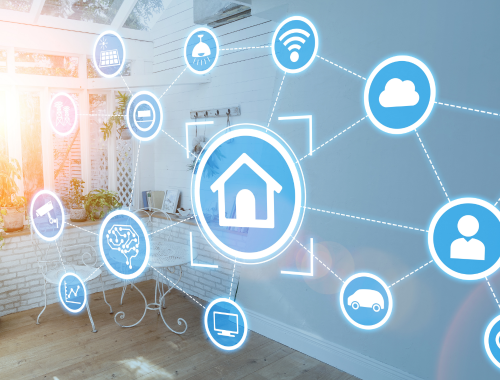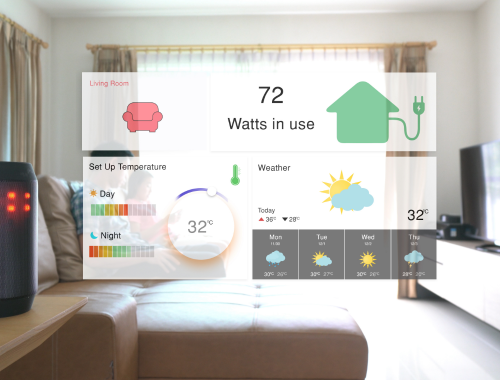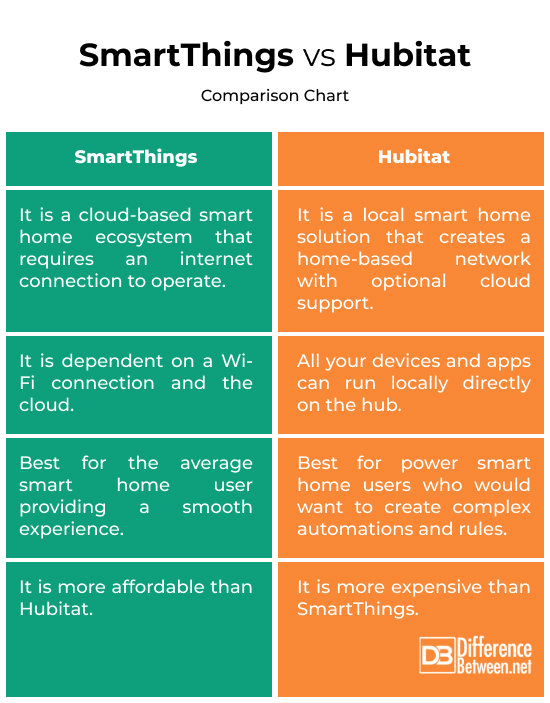Difference Between SmartThings and Hubitat
SmartThings and Hubitat are two popular home automation platforms that allow you to take control of all your smart devices, such as thermostats, smart lights, cameras, alarm systems, and more. They are like central hubs that enable communication between these smart devices, allowing users to interact with them and control them through a single easy-to-use interface. Both platforms make setting up and remote monitoring and control easier. But which one is better? Well, each platform has its own set of pros and cons. Let’s break it down. Read on to learn more about the two platforms and understand the key differences between SmartThings and Hubitat.

SmartThings
SmartThings is Samsung’s smart home platform that connects your smart devices to a central hub, from which you can control and monitor these devices from your smartphone. It’s like a remote monitoring system that allows you to stay connected to your smart devices remotely. For example, if you forgot to switch off the lights or the TV, you can do that using the SmartThings app. You just have to setup SmartThings and you’re good to go. You can also voice control your devices.

Hubitat
Hubitat is a relatively new, cloud-independent home automation solution designed to control various smart devices in your home locally. It is fast, reliable, and above all, operates locally, meaning it does not rely on the internet for most tasks, ensuring faster response times and increased privacy. You can connect a wide range of compatible smart devices, create your own automation rules, and control everything through a user-friendly interface.
Key Differences between SmartThings and Hubitat
Cloud Dependency
– SmartThings is a cloud-based smart home ecosystem that connects a wide range of mobile devices and home appliances to a central hub, allowing you to remotely control and monitor them through the SmartThings mobile app. All the custom automations and rules are processed on their servers. Hubitat, on the contrary, is a local, cloud-independent smart home solution that creates a home-based network to connect your devices to a hub that works without an internet connection. Hubitat is meant for privacy because it stores all your device data locally.
Device Integration
– SmartThings enables integration with a wide range of smart home devices and home appliances, such as refrigerators, ACs, TVS, sensors, smart bulbs, security cameras, alarm systems, smart locks, and much more. The best part; it supports a wide range of third-party devices that are not from the Samsung ecosystem, such as Hue bulbs. Hubitat also connects to a variety of devices, including lights, switches, thermostats, sensors, locks, garage door controllers, etc. However, the list of Hubitat-compatible devices is relatively smaller compared to SmartThings.
Ease of Use
– SmartThings has been around for a while, and as a result, it has established itself as a trusted smart home platform. It has a sleek, easy-to-use interface that is more user-friendly, making it easier for anyone to interact with the hub with fewer complications. It also supports a range of voice assistants, such as Google Assistant, Alexa, Bixby, etc. Hubitat, on the other hand, delivers unmatched speed and privacy, allowing users to create complex automations while providing data security.
SmartThings vs. Hubitat: Comparison Chart

Summary
Each platform has its fair share of strengths and weaknesses, depending on your smart home requirements and the devices you want to connect. If you are looking for a budget-friendly hub and want to connect only a limited number of devices without any complex integration, then SmartThings would be an excellent choice. Now, if you are more of a power user who would want to create complex automations and rules, then go for Hubitat; it’s a much better choice.
FAQs
Does SmartThings work with Hubitat?
Yes, the SmartThings app can be used as a dashboard to control all your Hubitat devices. You can integrate Hubitat with SmartThings to create more complex automations.
Will SmartThings be discontinued?
Samsung sold SmartThings to Aeotec in 2020, which means the hub is now manufactured by Aeotec. It isn’t discontinued; Samsung has plans to transform it into a more powerful, feature-rich, and universal platform.
Is Hubitat the best hub?
Hubitat is an excellent platform, but it is not the only smart hub out there. There are other players in the market, including Home Assistant, HomeSeer, SmartRent, and more.
Why did Samsung stop SmartThings?
Samsung just stopped making its own hardware, including the native hub. It has stopped selling its own SmartThings hubs and developing some of the features that were popular with power users. Now, Aeotec Smart Home Hub is the base for SmartThings devices.
What replaces SmartThings?
Samsung no longer makes the SmartThings hub. So, new customers need the Aeotec Smart Home Hub to use the SmartThings platform.
Who bought Samsung SmartThings?
Aeotec took over the SmartThings hardware portfolio in both the United States and European markets. New users can leverage SmartThings to create automations using the Aeotec Smart Home Hub. SmartThings, however, will offer ongoing support for existing devices and platform users.
- Difference Between Caucus and Primary - June 18, 2024
- Difference Between PPO and POS - May 30, 2024
- Difference Between RFID and NFC - May 28, 2024
Search DifferenceBetween.net :
Leave a Response
References :
[0]“SmartThings and Aeotec – A Connected Family.” SmartThings Blog, 16 Oct. 2020, https://blog.smartthings.com/roundups/smartthings-and-aeotec-a-connected-family/.
[1]Zaka, Hassan. “Hubitat vs SmartThings.” Home-Automations.Net, 18 Mar. 2020, https://home-automations.net/smartthings-vs-hubitat/.
[2]Dhanjani, NItesh. Abusing the Internet of Things: Blackouts, Freakouts, and Stakeouts. California, United States: O'Reilly Media, 2015. Print
[3]Image credit: https://www.canva.com/photos/MADnIo7h0_4-smart-house-concept-home-automation-/
[4]Image credit: https://www.canva.com/photos/MAEFCq8QcGI-home-automation-and-smart-home-technology-lighting-control/
